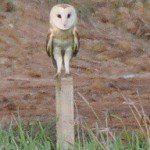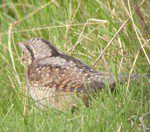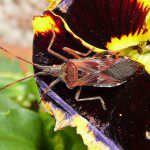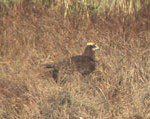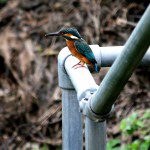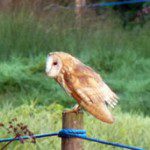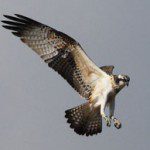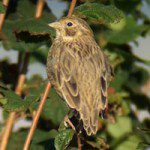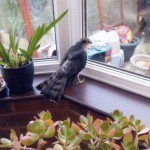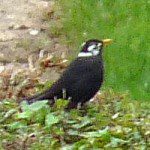Axe Estuary Birds No 141 30th September 2010
NB: The following is reproduced by kind permission of Axe Estuary Birds. Full credit goes to the team that produces the newsletter (see the bottom of the post for specific details). Photographs are credited throughout the text although we are working to preserve the original layout wherever possible in the future.
Photos: Osprey – John Crabb; Marsh Harrier – Steve Waite; Wryneck – Steve Waite; Corn Bunting – Gavin Haig; Barn Owl – Steve Waite. Barn Owl – Sue Smith, Kingfisher – Carol Lowe, Sparrowhawk (?) – Graham Stevens. Pied Headed Blackbird, Western Conifer Seed Bug – Peter Vernon
The Birds
The talk of the period has been the juvenile Osprey that has graced our Estuary. It was first spotted on 16th and departed on the morning of 27th. During its stay it could be seen to fish on the Estuary three or four times a day and it certainly attracted some visitors! Interestingly it was colour-ringed, and although full details on this bird haven’t been received yet it certainly isn’t a Scottish bird. There is a high chance it is in fact Norwegian.
A Marsh Harrier was a welcome sight over Colyford Marsh for a couple of days from 24th, this was after one had flown high west over the Estuary on 22nd – maybe the same bird?
A Wryneck on Seaton Marshes was very welcome indeed – though at times it could be very elusive. It was first seen on 24th and the sighting of it on 28th may well have been the last.
There is always an obvious shift in autumn migration at this time. Many of our ‘true’ summer migrants will not be seen again this year, and more northerly species are now migrating though – Meadow Pipits being the prime example. Over 1000 flew over Beer Head on 17th, with very few noted in similar conditions a week earlier. Yellow Wagtails, Tree Pipits, Redstarts and Whinchats are still being recorded though – just less frequently and in much lower numbers now. A nice (well, not that nice maybe!) distraction for migrant hunters visiting Beer Head has been the Corn Bunting that continues to reside in a stubble field, although well off the beaten track.
Wader passage is certainly tailing off, though there is still time for some niceties. In the period Dunlin numbers didn’t get above 30, and a dozen Ringed Plovers was as good as it got. The 29th did produce a little increase with a Little Stint and two Curlew Sandpipers on Black Hole Marsh. A lone Spotted Redshank as a nice highlight on 24th.
A couple of seawatches have been attempted during this period. On 19th two Sooty Shearwaters, nine Balearic Shearwaters, two Arctic Skuas and a Great Skua flew past during the afternoon. Then on 29th two Great Skuas and 98 Common Scoters flew past.
At least one Barn Owl is still showing well in the valley. Black Hole Marsh proving the best place to see it – sometimes in broad daylight!
Holyford Woods
Over the last month there have been more signs of autumn everywhere, most noticeable the bracken turning golden brown. I had a wonderful view of the Roe buck one morning, when Paco disturbed him in the gorse below The Hangings and he took a tremendous leap high over the path and down to the stream. Yesterday evening I was picking blackberries along the Hangings, when I heard a Roe deer barking on the hill above me. Looking up I got a brief view of a doe ‘pronging’ among the thick brambles. Was it her or was the buck nearby? Earlier in the month I was again blackberrying along The Hangings, when my attention was drawn to a nearby bramble patch where 2 Chiffchaffs were busy feeding and calling quietly. The young Buzzards are still very vocal, and one morning from the conifers there was an adult Raven croaking, accompanied by a youngster making a strange gargling call, begging to be fed. They both flew off, the youngster continuing to pester its parent. The Jays have been very active in the oaks, and among many birds seen and or heard are Nuthatch, Tree Creeper, Great Spotted and Green Woodpecker, a small flock of Gold Crest, 6+ Long Tailed Tits, several Wrens, back now in greater numbers. Jean Kreieler.
The Trivia
The ‘Inspirations’ 2011 calendar produced by the Seaton Visitor Centre Trust/KiSTA (Kick Start The Arts) is now on sale for £5.99 at Eve’s Gallery, Fore Street, Seaton, EX12 2LA or by post for £7.50 All the photographs are local scenes and wildlife and taken by locals. Readers of this newsletter will know several of them.
A lovely view of our Kingfisher by Carol Lowe, and an unusual conservatory visitor for Graham Stevens of Colyford.
Peter Vernon recently photographed a specimen of a new introduction of bug into the UK (first seen 2008) it is called Leptoglossus occidentalis Western Conifer Seed Bug He spotted this one on a pot of Pansies outside his front door. It has probably become fairly widespread now in the South West. Please see this link to the species. http://www.britishbugs.org.uk/heteroptera/Coreidae/leptoglossus_occidentalis.html
Peter also took this image (the other day of the very rare Pied Headed Blackbird seen opposite his cottage. He believes this to be the first record of this species for Devon?!
Migrating Swallows provided an unusual spectacle over Colyton on Monday 21st. The Midweek Herald reported that between 7 pm and 7.30 several thousand Swallows caused the sky to turn black for about 20 minutes. An unusual sight indeed.
Ringing
The demonstration on 18th September went well with a few members of the public and a group of members from the RSPB Exeter branch. A total of 45 birds were caught as follows:
Greenfinch 18(1); Blue Tit 5(1); Sedge Warbler 4; Great Tit (1); Chaffinch 1; Wren 2; Chiffchaff 4; Robin 2(1); Dunnock 1; Kingfisher 4(3); Goldfinch 2; and Treecreeper 1. The last is an unusual species for the marsh believed to be the second to be ringed at the site. Mike Tyler.
Donald Campbell will be standing down from his webs counts at the end of the year and will be looking for a replacement. There will also be a note in the Harrier. “After many years involvement I am no longer doing it properly but switch into automatic gear making assumptions rather than doing accurate counting. I cover Lower Bruckland separately from the estuary, but obviously it is the estuary that is vital and I am available to show any potential successor the ropes. Any one interested should contact me and Peter Reay. He is Devon Webs organiser email peter.p.j.reay@btinternet.com phone 01364 773293 address Crooked Fir, Moorland Park, South Brent, TQ10 9AS.
Diary Dates
Sunday 3rd October 9.00 am Birds from the tram with Donald Campbell
Thursday 7th October 10 am to 12 Noon Meet the Birds at Colyford Common
Sunday 17th October 9.00 am Birds from the tram with Don Cotton
Saturday 23rd October 9.00 am Birds from the Tram for Juniors with James Chubb
Thursday 28th October 10 am to 12 Noon Meet the Birds at Seaton Marshes
Thursday 28th October 7.30 pm Illustrated talk “The Birds of Devon” by Mike Tyler, Chairman of
DBWPS. At All Saints Church, Sidmouth.
This twice-monthly email newsletter is freely available to anyone who would like it, as is a periodic one about the activities of the East Devon Local Group of the Devon Wildlife Trust. Just send me an email with Axe Estuary Birds and/or East Devon DWT in the subject line. Also, for those without a computer, I will send a copy by post if you would like to send me some stamps.
Thanks to those who keep me informed – please continue to tell us of any unusual, interesting or amusing sightings, and what is about locally, and send any photos you would like to share.
Steve, Mike, Jean and David. davidwalters@eclipse.co.uk. tel. 01297 552616 Mobile 0779 1541 744.

